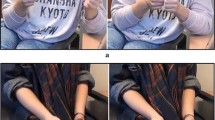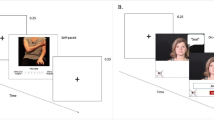Abstract
Previous research has shown that iconic gestures are effective at communicating semantic information, particularly about the size and relative position of objects. However, the conclusions of these experiments have been somewhat limited by the fact that the methodology has typically involved presenting gesture–speech samples on video rather than in an actual face-to-face context. Because these different viewing conditions can impact on addressees’ behavior and perception, and therefore potentially impact on the amount of information they receive from gestures, the present study compares the communicative effectiveness of iconic gestures when viewed in a face-to-face context compared to when viewed on video. The results are quite striking in that gestures seemed at least as effective, and in some cases even more effective at communicating position and size information when they occurred in the face-to-face condition compared to video.



Similar content being viewed by others
References
Argyle, M. (1975). Bodily communication. London: Routledge.
Argyle, M., & Cook, M. (1976). Gaze and mutual gaze. Cambridge: Cambridge University Press.
Argyle, M., & Ingham, R. (1972). Gaze, mutual gaze, and proximity. Semiotica, 1, 32–49.
Beattie, G. (1983). Talk: An analysis of speech and non-verbal behaviour in conversation. Milton Keynes: Open University Press.
Beattie, G. (2003). Visible thought: The new psychology of body language. London: Routledge.
Beattie, G., & Shovelton, H. (1999a). Do iconic hand gestures really contribute anything to the semantic information conveyed by speech? An experimental investigation. Semiotica, 123, 1–30.
Beattie, G., & Shovelton, H. (1999b). Mapping the range of information contained in the iconic hand gestures that accompany spontaneous speech. Journal of Language and Social Psychology, 18, 438–462.
Beattie, G., & Shovelton, H. (2001). An experimental investigation of the role of different types of iconic gesture in communication: A semantic feature approach. Gesture, 1, 129–149.
Beattie, G., & Shovelton, H. (2002). An experimental investigation of some properties of individual iconic gestures that mediate their communicative power. British Journal of Psychology, 93, 179–192.
Beattie, G., & Shovelton, H. (2005). Why the spontaneous images created by the hands during talk can help make TV advertisements more effective. British Journal of Psychology, 96, 21–37.
Beattie, G., & Shovelton, H. (in press). An exploration of the other side of semantic communication. How the spontaneous movements of the human hand add crucial meaning to narrative. Semiotica.
Broaders, S. C., Cook, S. W., Mitchell, Z., & Goldin-Meadow, S. (2007). Making children gesture brings out implicit knowledge and leads to learning. Journal of Experimental Psychology: General, 136, 539–550.
Butterworth, B. (1975). Hesitation and semantic planning in speech. Journal of Psycholinguistic Research, 4, 75–87.
Darwin, C. (1872). The expression of the emotions in man and animals. London: John Murray.
Ekman, P. (1993). Facial expression and emotion. American Psychologist, 48, 384–392.
Ekman, P. (1999). Facial expressions. In T. Dalgleish & T. Power (Eds.), The handbook of cognition and emotion (pp. 301–320). Sussex, UK: Wiley.
Ekman, P., Friesen, W. V., & Ancoli, S. (1980). Facial signs of emotional experience. Journal of Personality and Social Psychology, 39, 1125–1134.
Goldin-Meadow, S. (2003). Hearing gesture: How our hands help us think. London: Belknap Press of Harvard University Press.
Goodwin, C. (1981). Conversational organization: Interaction between speakers and hearers. New York: Academic Press.
Graham, J. A., & Argyle, M. (1975). A cross-cultural study of the communication of extra-verbal meaning by gestures. Journal of Human Movement Studies, 1, 33–39.
Gullberg, M. (2003). Eye movements and gestures in human interaction. In J. Hyönä, R. Radach, & H. Deubel (Eds.), The mind’s eyes: Cognitive and applied aspects of eye movements (pp. 685–703). Oxford: Elsevier.
Gullberg, M., & Holmqvist, K. (1998). Focus on gesture: Visual attention towards gestures in conversation. LUCS, Lund: Department of Cognitive Science.
Gullberg, M., & Holmqvist, K. (2006). What speakers do and what addressees look at: Visual attention to gestures in human interaction live and on video. Pragmatics & Cognition, 14, 53–82.
Holler, J. (2003). Semantic and pragmatic aspects of representational gestures: Towards a more unified model of communication. Unpublished doctoral thesis, University of Manchester, UK.
Holler, J., & Beattie, G. (2002). A micro-analytic investigation of how iconic gesture and speech represent core semantic features in talk. Semiotica, 142, 31–69.
Holler, J., & Beattie, G. (2003). Pragmatic aspects of representational gestures: Do speakers use them to clarify verbal ambiguity for the listener? Gesture, 3, 127–154.
Kendon, A. (1967). Some functions of gaze-direction in social interaction. Acta Psychologica, 26, 22–63.
Kendon, A. (1980). Gesticulation and speech: Two aspects of the process of utterance. In M. Ritchie Key (Ed.), The relationship of verbal and nonverbal communication (pp. 207–227). The Hague: Mouton.
Kendon, A. (2000). Language and gesture: Unity or duality? In D. McNeill (Ed.), Language and gesture (pp. 47–63). Cambridge: Cambridge University Press.
Kendon, A. (2004). Gesture: Visible action as utterance. Cambridge: Cambridge University Press.
McNeill, D. (1985). So you think gestures are nonverbal? Psychological Review, 92, 350–371.
McNeill, D. (1992). Hand and mind: What gestures reveal about thought. Chicago: University of Chicago Press.
Riseborough, M. G. (1981). Physiographic gestures as decoding facilitators: Three experiments exploring a neglected facet of communication. Journal of Nonverbal Behavior, 5, 172–183.
Roebers, C. M., Gelhaar, T., & Schneider, W. (2004). ‘It’s magic!’ The effects of presentation modality on children’s event memory, suggestibility, and confidence judgments. Journal of Experimental Child Psychology, 87, 320–335.
Rogers, W. T. (1978). The contribution of kinesic illustrators toward the comprehension of verbal behaviors within utterances. Human Communication Research, 5, 54–62.
Thierry, K. L., & Spence, M. J. (2004). A real-life event enhances the accuracy of preschoolers’ recall. Applied Cognitive Psychology, 18, 297–309.
Acknowledgments
We would like to thank two anonymous reviewers, as well as Prof. Judith Hall, for their invaluable comments on an earlier version of this manuscript. We would also like to thank Lucy Treanor for her assistance in collecting the data, William Newell for his invaluable acting performances, as well as the participants who took part in this investigation. The research was funded through a grant from the Faculty of Medical and Human Sciences at the University of Manchester awarded to Judith Holler. During the duration of this study, Geoffrey Beattie and Heather Shovelton were supported by a research grant from the Economic and Social Research Council (RES-000-22-1917).
Author information
Authors and Affiliations
Corresponding author
Appendices
Appendix 1
Example cartoon script (for ‘Billy Whizz’) including speech and gestures (the gesture description is included in square brackets and transcribed in italics underneath and the part of speech that it accompanies. Images of the gestures are also included; the speaker’s face has been blurred in these images to provide anonymity). Insertions mark the parts of the narrative originally contributed by different speakers (here, speakers 1–4):
[SPEAKER 1:] It’s a family, with a woman, a husband and a little child. And the father’s saying ‘We’d like to buy a kitchen table and chair set.’ And the salesman in the furniture shop says ‘Certainly.’ And so then the salesman says ‘How about a bench set instead of a table and chair set’ and the father says that that’s not very safe, because he imagines them having breakfast and Billy is throwing the food all over the chairs. Then he says ‘It’s no use for our Billy’. So the salesman says ‘How about a table with single swivel chairs?’ And the Mother says ‘Oh no, we’ve had chairs like those before.’ And she remembers when Billy jumped onto the table instead of onto the chairs and the table went [spinning and all the food went all over the floor].
Right arm moves in two large clockwise circles, while the left hand moves away from the right arm
And she says ‘Yikes, he’s like a mad spinning top.’ So the salesman comes up with a solution, ‘I have the very table to suit you. It will be very safe.’ So the Mum says ‘Great.’ [SPEAKER 2:] And the guy has come up with a particular kitchen table set which is, it’s on a [pole which] moves up and down.
Hands apart, palms pointing towards each other, fingers curved, hands make two large rapid movements up and down
[SPEAKER 3:] So when Billy comes in he says ‘Where are the family?’ as the table can be [raised up towards the ceiling], so he can’t jump onto the table.
Hands are shoulder width apart, palms facing down, hands move upwards
And the Father says ‘Ha ha, the table lifts us out of harms way.’ [SPEAKER 4:] But then Billy’s laughing his head off ‘cos the table then moves to the very top of the ceiling and squashes the entire family.
Appendix 2

Rights and permissions
About this article
Cite this article
Holler, J., Shovelton, H. & Beattie, G. Do Iconic Hand Gestures Really Contribute to the Communication of Semantic Information in a Face-to-Face Context?. J Nonverbal Behav 33, 73–88 (2009). https://doi.org/10.1007/s10919-008-0063-9
Received:
Accepted:
Published:
Issue Date:
DOI: https://doi.org/10.1007/s10919-008-0063-9




